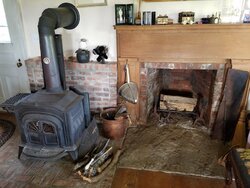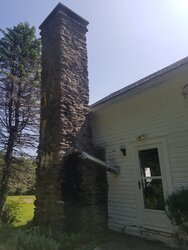I moved last year to a house in southern Vermont. The house came with a woodstove with a suboptimal installation. The stove itself (a old Vermont Castings Resolute III) is in good shape, but the exhaust goes through a wall as Class A pipe, makes a right angle bend, and then enters the outside of a massive stone chimney. It then connects (badly) to a 8" round ceramic flue that goes to the top. We limped through with it like this last winter, but it's got some severe issues. Instead, I'd like to move the stove be in front of the fireplace next to it, and upgrade to an insulated stainless flue liner that goes all the way to the top of the chimney.


There's some trickiness with doing this, however, and I'm not sure of the best solution. The first issue is that the chimney is very tall (about 30 feet), and has a extremely heavy concrete cap on top of it. Removing the cap and getting safe access to insert a liner from the top is going to be very difficult, so I'm hoping that I can install the liner from the bottom, while keeping the top cap in place. I haven't seen this approach discussed anywhere, but is there any reason this can't be done?
Inside the fireplace, the moveable part the damper has rusted out and been removed (standing to right of fireplace in photo). Currently I've got about a 7.5" gap at a 45° angle between the fixed portion of the damper and the brick through which I can insert the flue, or I can use an angle grinder to enlarge the opening as necessary. The flue itself is a 12-13" round ceramic starting about 5' up, so once I get to there I should be fine. I'm assuming I'll drop a rope down the flue, put some sort of a pulley on the top, attach a pulling cone to the liner, and then guide it in from the inside while someone on the outside hauls on the rope. Is this going to work?
Once I can get it to the top, I'm assuming I can lock it off to a top plate that I slide underneath the heavy cap. I have about 10" to work with while I make the connection from a ladder. I'm thinking that an upside down top plate like this might work: https://www.rockfordchimneysupply.c...nts/round-liner-components/flat-top-plate.php. Is there any reason that a top plate like this cannot be installed upside down, with the collar pointing down, so the plate is flush with the top of the flue?
Backing up a little, is there a specific liner that should I use? Reading through the archives, the strong suggestion seems to be to avoid the lightweight two-ply smooth interior liners. It sounds like all the preinsulated liners are lightweight, but wrapping with insulation doesn't seem too difficult. And it seems useful that the heavier weight single wall liners are actually more flexible. I don't feel I understand the difference in alloys, though. I'm willing to pay more for a good liner that will last longer. Does anyone have a specific recommendation for a medium or heavy weight liner that I can buy as an end user?
The next part of the project will be blocking off the opening to the chimney, preferably in some insulated way. The usual approach seems to be to use just a blocking plate at the height of the old flue, but since we'd like to have a free-standing stove instead of an insert, and since the chimney is a gigantic uninsulated mass exposed directly to the outside, I'd rather not have the bricks and stonework exposed to the interior. My thought is to build some sort of insulated but non-combustible wall at the opening of the fireplace, with access the new flue via a thimble mounted in that new wall.
I'm not finding examples of people who have taken this approach, but I'm not sure why. Is it a bad idea for some reason? If it is reasonable, what would be the right materials to use to block off the opening? I could easily do a small piece of stud wall with an insulated thimble passing through, but it seems silly to build something new and combustible behind where the stove will go even if the stove pipe penetration itself is safe. Bricking it up would be non-combustible, but I'm not sure how to effectively insulate it. Perhaps two wythes of brick with perlite or mineral wool in between? Having thermal mass inside the insulation would be great if I can manage it.
If I get that far, the next step would probably be to enlarge the hearth. And we'll probably upgrade the stove as well to something modern. But these are separate questions that I can ask after I've figured out how to install the flue itself.
Thanks!


There's some trickiness with doing this, however, and I'm not sure of the best solution. The first issue is that the chimney is very tall (about 30 feet), and has a extremely heavy concrete cap on top of it. Removing the cap and getting safe access to insert a liner from the top is going to be very difficult, so I'm hoping that I can install the liner from the bottom, while keeping the top cap in place. I haven't seen this approach discussed anywhere, but is there any reason this can't be done?
Inside the fireplace, the moveable part the damper has rusted out and been removed (standing to right of fireplace in photo). Currently I've got about a 7.5" gap at a 45° angle between the fixed portion of the damper and the brick through which I can insert the flue, or I can use an angle grinder to enlarge the opening as necessary. The flue itself is a 12-13" round ceramic starting about 5' up, so once I get to there I should be fine. I'm assuming I'll drop a rope down the flue, put some sort of a pulley on the top, attach a pulling cone to the liner, and then guide it in from the inside while someone on the outside hauls on the rope. Is this going to work?
Once I can get it to the top, I'm assuming I can lock it off to a top plate that I slide underneath the heavy cap. I have about 10" to work with while I make the connection from a ladder. I'm thinking that an upside down top plate like this might work: https://www.rockfordchimneysupply.c...nts/round-liner-components/flat-top-plate.php. Is there any reason that a top plate like this cannot be installed upside down, with the collar pointing down, so the plate is flush with the top of the flue?
Backing up a little, is there a specific liner that should I use? Reading through the archives, the strong suggestion seems to be to avoid the lightweight two-ply smooth interior liners. It sounds like all the preinsulated liners are lightweight, but wrapping with insulation doesn't seem too difficult. And it seems useful that the heavier weight single wall liners are actually more flexible. I don't feel I understand the difference in alloys, though. I'm willing to pay more for a good liner that will last longer. Does anyone have a specific recommendation for a medium or heavy weight liner that I can buy as an end user?
The next part of the project will be blocking off the opening to the chimney, preferably in some insulated way. The usual approach seems to be to use just a blocking plate at the height of the old flue, but since we'd like to have a free-standing stove instead of an insert, and since the chimney is a gigantic uninsulated mass exposed directly to the outside, I'd rather not have the bricks and stonework exposed to the interior. My thought is to build some sort of insulated but non-combustible wall at the opening of the fireplace, with access the new flue via a thimble mounted in that new wall.
I'm not finding examples of people who have taken this approach, but I'm not sure why. Is it a bad idea for some reason? If it is reasonable, what would be the right materials to use to block off the opening? I could easily do a small piece of stud wall with an insulated thimble passing through, but it seems silly to build something new and combustible behind where the stove will go even if the stove pipe penetration itself is safe. Bricking it up would be non-combustible, but I'm not sure how to effectively insulate it. Perhaps two wythes of brick with perlite or mineral wool in between? Having thermal mass inside the insulation would be great if I can manage it.
If I get that far, the next step would probably be to enlarge the hearth. And we'll probably upgrade the stove as well to something modern. But these are separate questions that I can ask after I've figured out how to install the flue itself.
Thanks!
Last edited by a moderator:

